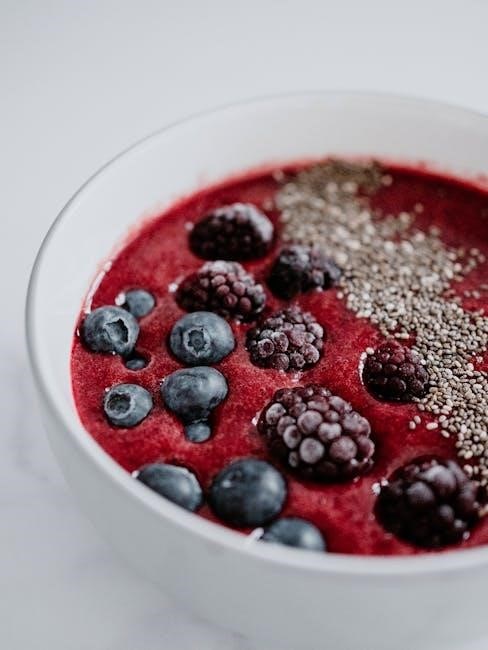A gluten and dairy-free diet excludes gluten-containing grains and dairy products, promoting better health for those with intolerances or preferences․ This guide provides a comprehensive gluten and dairy-free food list PDF, helping you identify safe foods and alternatives like rice, quinoa, and dairy-free cheese․
Overview of Gluten and Dairy-Free Diets
Gluten and dairy-free diets are increasingly popular due to growing awareness of food intolerances, allergies, and lifestyle choices․ These diets exclude gluten, found in grains like wheat, barley, and rye, and dairy products derived from milk․ The gluten and dairy-free food list PDF serves as a valuable resource, helping individuals identify safe foods and alternatives․ It includes options like rice, quinoa, and non-dairy milk, ensuring balanced nutrition․ The list also highlights hidden sources of gluten and dairy, such as additives in processed foods, empowering users to make informed choices․ Whether for medical necessities or personal preferences, this guide simplifies navigating a gluten and dairy-free lifestyle, making grocery shopping and meal planning easier and stress-free․ It’s a practical tool for maintaining a healthy and enjoyable diet․

Importance of a Gluten and Dairy-Free Food List
A gluten and dairy-free food list is essential for individuals with intolerances, allergies, or those choosing a restrictive diet․ It helps avoid harmful ingredients like gluten and dairy, ensuring safety and health․ The list provides clarity on acceptable foods, such as rice, quinoa, and non-dairy milk, while highlighting hidden sources of gluten and dairy in processed foods․ This resource simplifies grocery shopping and meal planning, reducing confusion and stress; By identifying safe alternatives, it ensures a balanced and nutritious diet․ For many, a gluten and dairy-free food list PDF becomes a indispensable guide, empowering them to manage their dietary needs confidently and effectively․ It’s a practical tool for maintaining a healthy and enjoyable lifestyle, free from unwanted reactions․

Understanding Gluten-Free Foods
Gluten-free foods exclude ingredients containing gluten, such as wheat, barley, and rye․ Key options include rice, quinoa, and buckwheat․ A gluten and dairy-free food list PDF helps identify safe choices and hidden gluten sources, ensuring a balanced diet for those with intolerances or preferences․
What is Gluten?
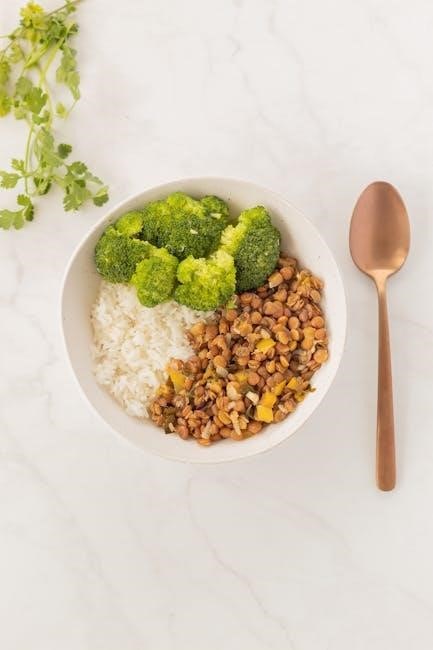
Gluten is a protein found in wheat, barley, and rye, providing elasticity to dough and structure to baked goods․ It is naturally present in these grains and can also be added to processed foods․ Many people, including those with celiac disease or gluten sensitivity, must avoid gluten due to adverse health reactions․ A gluten and dairy-free food list PDF is essential for identifying safe options, as hidden gluten can appear in unexpected products like sauces, processed meats, and even some snacks․ Understanding gluten sources is crucial for maintaining a gluten-free diet, ensuring better health and preventing potential complications․ Always check labels and refer to your food list for guidance․
Common Gluten-Free Grains and Alternatives
When following a gluten-free diet, there are numerous grains and alternatives that can be enjoyed․ Rice, both white and brown, is a popular choice, offering a neutral flavor and versatility․ Quinoa, a complete protein, is another excellent option, along with almond flour, which is ideal for baking․ Buckwheat, despite its name, is gluten-free and adds a nutty flavor to dishes․ Millet, a small-grained cereal, is easy to digest and packed with nutrients․ Amaranth, though less common, is a nutritious gluten-free grain․ These alternatives provide fiber, vitamins, and texture to meals, making them essential additions to a gluten-free food list․ Including them in your diet ensures variety and nutritional balance, while also adhering to gluten-free guidelines․
Hidden Sources of Gluten in Foods
Identifying hidden sources of gluten is crucial for maintaining a gluten-free diet․ Many processed foods contain gluten in unexpected forms, such as fillers, thickeners, or stabilizers․ Examples include soy sauce, modified food starch, and malt vinegar, which are often derived from gluten-containing grains․ Some medications and vitamins may also contain gluten as an inactive ingredient․ Additionally, foods like energy bars, flavored coffees, and even some chocolate products may harbor gluten․ Cross-contamination in processing facilities can also introduce gluten into seemingly gluten-free foods, such as oats․ Always check labels for certification or explicit “gluten-free” claims to avoid unintentional exposure․ Awareness of these hidden sources is key to ensuring a safe and effective gluten-free diet․
Understanding Dairy-Free Foods
A dairy-free diet eliminates all milk-derived products, including cheese, yogurt, and butter, often due to lactose intolerance or dietary preferences․ Plant-based alternatives like almond, coconut, and oat milk are popular substitutes․ Always check labels to ensure no hidden dairy ingredients are present in processed foods․
What is Dairy?
Dairy refers to products derived from milk, primarily from cows, goats, sheep, and buffalo․ Common dairy products include milk, cheese, yogurt, butter, and ice cream․ Dairy contains lactose, a sugar, and proteins like casein and whey, which can cause intolerance or allergies in some individuals․ Lactose intolerance occurs when the body lacks the enzyme lactase, leading to digestive issues․ Dairy is also avoided for dietary preferences, such as veganism, or due to conditions like milk protein allergies․ Understanding dairy is crucial for creating a gluten and dairy-free food list, ensuring all milk-derived ingredients are identified and replaced with suitable alternatives․ This helps individuals maintain a balanced and safe diet while avoiding adverse reactions or aligning with lifestyle choices․
Common Dairy-Free Alternatives
For those avoiding dairy, numerous alternatives are available to replicate the taste and functionality of traditional dairy products․ Plant-based milks, such as almond, soy, oat, and coconut milk, are popular substitutes for cow’s milk․ These options are often fortified with calcium, vitamin D, and other nutrients to mimic dairy’s nutritional profile․ Yogurt alternatives, made from coconut, almond, or soy, provide similar probiotic benefits without dairy․ Vegan cheeses, crafted from nuts, seeds, or soy proteins, offer a dairy-free solution for dishes requiring cheese․ Butter substitutes like coconut oil or vegan butter spreads are ideal for baking and cooking․ These alternatives ensure that individuals can enjoy a balanced diet while adhering to dairy-free requirements, making them essential additions to any gluten and dairy-free food list․
Hidden Sources of Dairy in Foods
Identifying hidden dairy in foods is crucial for maintaining a dairy-free diet․ Many processed foods contain dairy derivatives, such as whey, lactose, or casein, which may not be immediately obvious․ For instance, some bread, cereals, and crackers include butter or milk powder․ Processed meats, like hot dogs or sausages, may contain dairy fillers․ Even certain medications or supplements, such as some vitamins, can include lactose as an additive․ Additionally, foods like granola, energy bars, and flavored coffees or teas may have dairy-based ingredients․ Reading food labels carefully is essential to avoid unintentional dairy consumption․ A detailed gluten and dairy-free food list can help individuals identify these hidden sources and make informed choices to stay compliant with their dietary restrictions․

Gluten and Dairy-Free Food Categories
Organizing foods into categories simplifies gluten and dairy-free diets․ Explore grains, proteins, fruits, vegetables, snacks, dairy alternatives, condiments, and sweet treats for a balanced approach․
Grains and Starches
Grains and starches form the foundation of many meals in a gluten and dairy-free diet․ Rice, quinoa, corn, and millet are excellent gluten-free options․ Alternative flours like almond, coconut, and cassava flour are perfect for baking․ Potatoes, sweet potatoes, and tapioca are great starches for adding texture and energy to dishes․ Many grains and starches are naturally dairy-free, making them ideal for those with dietary restrictions․ Always verify labels to ensure they are processed in gluten-free facilities to avoid cross-contamination․ Incorporating a variety of these options ensures a balanced and nutritious diet while adhering to gluten and dairy-free requirements․ They provide sustained energy and versatility for both savory and sweet recipes․
Proteins and Meats
Proteins and meats are essential components of a gluten and dairy-free diet․ Chicken, turkey, beef, and fish are naturally gluten and dairy-free, provided they are not marinated or processed with gluten-containing ingredients․ Wild game meats like bison and venison are also excellent options․ Pork and lamb can be included as long as they are free from added gluten or dairy․ Plant-based proteins such as beans, lentils, tofu, and tempeh are great alternatives, though ensure they are processed in gluten-free facilities․ Nuts and seeds also provide protein and healthy fats․ Always check labels for hidden gluten or dairy in processed meats and plant-based products․ Opting for fresh, unprocessed options is the safest choice․ This category offers a wide variety of flavors and textures for a balanced diet․
Fruits and Vegetables
Fruits and vegetables are naturally gluten and dairy-free, making them a cornerstone of a gluten and dairy-free diet․ Fresh options like berries, citrus fruits, apples, bananas, and tropical fruits are excellent choices․ Leafy greens such as spinach, kale, and lettuce, along with root vegetables like carrots, potatoes, and sweet potatoes, are also ideal․ Most fruits and vegetables are rich in essential vitamins, minerals, and antioxidants, providing numerous health benefits․ They can be enjoyed raw, cooked, or incorporated into salads and snacks․ Fresh produce is versatile and offers a wide range of flavors and textures to enhance meals․ Always opt for fresh, whole options to avoid potential cross-contamination with gluten or dairy during processing․ Fruits and vegetables are a great way to add variety and nutrition to your diet․
Snacks and Convenience Foods
Snacks and convenience foods play a crucial role in maintaining a gluten and dairy-free lifestyle․ Many options are naturally free from gluten and dairy, such as nuts, seeds, and dried fruits․ Fresh fruit, veggie sticks with hummus, and energy bars made from certified gluten-free and dairy-free ingredients are excellent choices․ Popcorn, when prepared without dairy-based seasonings, is another safe option․ Granola and crackers labeled as gluten-free can also be included, provided they are free from dairy․ Always check labels to ensure products meet dietary requirements․ These snacks are convenient, nutritious, and can easily be incorporated into a daily routine․ They provide a quick energy boost and satisfy cravings without compromising dietary restrictions․ Reading labels carefully is essential to avoid hidden gluten or dairy in processed foods․
Dairy-Free Alternatives
Dairy-free alternatives are essential for those avoiding dairy products due to allergies, intolerances, or dietary preferences․ Popular options include plant-based milks such as almond, soy, oat, and coconut milk․ Vegan cheeses made from nuts, seeds, or soy are great substitutes for traditional cheese․ Yogurt alternatives, like coconut yogurt or soy yogurt, provide similar textures and probiotic benefits without dairy․ Ice cream can be enjoyed in dairy-free forms made from banana, coconut, or cashew bases․ Butter substitutes, such as coconut oil or vegan butter, are versatile for cooking and baking․ These alternatives are widely available and cater to various tastes and needs, making it easier to maintain a dairy-free lifestyle while enjoying familiar flavors and textures․ Always check labels to ensure they are free from dairy and gluten․
Condiments and Sauces
Condiments and sauces can enhance the flavor of meals while adhering to a gluten and dairy-free diet․ Common options include tamari (gluten-free soy sauce), coconut aminos, olive oil, and apple cider vinegar․ Herbs, spices, and seasonings like salt, pepper, garlic, and paprika are naturally free from gluten and dairy․ For sauces, consider hummus, tahini, guacamole, and salsas made with fresh ingredients․ Many store-bought condiments are gluten and dairy-free, but always check labels for hidden additives․ Homemade versions of sauces and dressings, such as vinaigrettes or marinades, allow for full control over ingredients․ These condiments and sauces add variety and flavor to meals without compromising dietary restrictions, making them essential additions to a gluten and dairy-free food list․
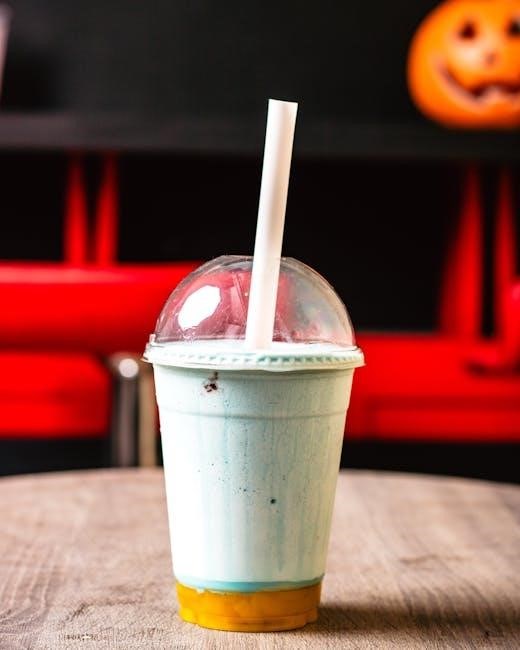
Sweet Treats and Desserts
Satisfying your sweet tooth on a gluten and dairy-free diet is easy with the right options․ Naturally sweet fruits like berries, bananas, and citrus are ideal for desserts․ Baked goods can be made using gluten-free flours such as almond, coconut, or rice flour․ Dairy-free chocolate, made from ingredients like cocoa and coconut sugar, is a great treat․ Sorbet, chia pudding, and fruit-based desserts like crisps or tarts are delicious alternatives․ Homemade treats like energy balls, made with dates and nuts, are also popular․ These options ensure that desserts remain flavorful and enjoyable while adhering to dietary restrictions, making them a delightful addition to any gluten and dairy-free food list․
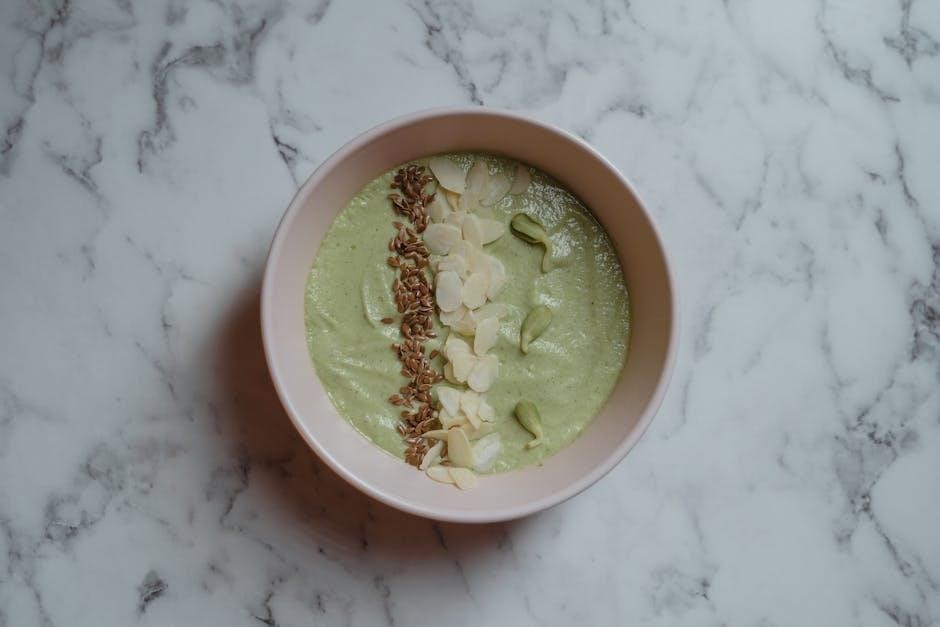
Creating a Comprehensive Food List
Creating a comprehensive food list is essential for managing gluten and dairy-free diets․ It helps in organizing meals, ensuring nutrition, and maintaining variety easily․
How to Build a Personalized Food List
Building a personalized gluten and dairy-free food list begins with identifying your dietary needs and preferences․ Start by categorizing foods into groups like grains, proteins, fruits, and vegetables․ Include gluten-free options such as rice, quinoa, and corn, and dairy-free alternatives like almond milk and coconut yogurt․ Highlight hidden sources of gluten and dairy in processed foods․ Consider adding a section for snacks and convenience items to ensure variety․ Use a gluten and dairy-free food list PDF as a reference to streamline the process․ Customize the list by adding personal favorites and noting any additional allergies or intolerances․ Regularly update the list based on new discoveries or dietary changes․ This approach ensures a balanced, enjoyable, and tailored eating plan that aligns with your health goals․
Essential Foods to Include
When creating a gluten and dairy-free food list, focus on incorporating nutrient-dense foods that provide balanced nutrition․ Start with whole grains like rice, quinoa, and corn, which are naturally gluten-free․ Include lean proteins such as chicken, turkey, fish, and plant-based options like beans and lentils․ Fresh fruits and vegetables are foundational, offering vitamins, minerals, and fiber․ Healthy fats like avocados, nuts, seeds, and olive oil are also crucial for energy and brain health․ Don’t forget to add gluten-free flours like almond or coconut flour for baking․ Dairy-free alternatives such as almond milk, coconut yogurt, and vegan cheeses can enhance variety․ Herbs, spices, and condiments like olive oil, vinegar, and tamari add flavor without gluten or dairy․ Including these essentials ensures a well-rounded and satisfying diet․
Foods to Avoid
When following a gluten and dairy-free diet, it’s critical to avoid certain foods to prevent adverse reactions․ Gluten-containing foods include wheat, barley, rye, and products made from these grains, such as bread, pasta, cereals, and baked goods․ Avoid processed foods with ingredients like wheat flour, malt, and brewer’s yeast․ Dairy products to eliminate include milk, cheese, yogurt, butter, and ice cream, as well as foods containing lactose or dairy by-products․ Be cautious of hidden sources of gluten and dairy in sauces, dressings, and processed snacks․ Always read labels to identify potential allergens like casein, whey, and hydrolyzed wheat protein․ Eliminating these foods helps ensure a safe and effective gluten and dairy-free dietary plan․
Meal Planning and Grocery Shopping
Meal planning and grocery shopping are essential for maintaining a gluten and dairy-free diet․ Plan balanced meals, create shopping lists, and explore strategies to simplify the process․
Sample Meal Plan
A sample meal plan for a gluten and dairy-free diet can help streamline your daily nutrition․ Start with breakfast options like gluten-free oats with fresh berries and almond milk․ For lunch, consider grilled chicken or fish salads with mixed greens, avocado, and olive oil dressing․ Dinner ideas include quinoa stir-fries with vegetables or baked salmon with roasted sweet potatoes․ Snacks could be fresh fruit, nuts, or energy balls made from dates and coconut․ Use your gluten and dairy-free food list to ensure all ingredients align with dietary restrictions․ This plan not only simplifies meal preparation but also ensures a balanced intake of nutrients․ Adjust portions and ingredients based on preferences and dietary needs for a personalized approach․
Reading Food Labels

Reading food labels is crucial when following a gluten and dairy-free diet․ Always check for certification marks like the Gluten-Free Certification Organization or dairy-free symbols, ensuring products meet dietary standards․ Look for ingredients like “wheat,” “barley,” or “rye” for gluten, and “milk,” “lactose,” or “casein” for dairy․ Be aware of hidden sources, such as gluten in soy sauce or dairy in some chocolate․ Use your gluten and dairy-free food list as a reference to identify safe ingredients․ When shopping, double-check labels for certifications and cross-reference with your list to avoid accidental exposure․ This practice ensures compliance with your dietary restrictions and builds confidence in making informed choices․ Over time, it becomes second nature to identify safe and unsafe products quickly․
Shopping Tips for Gluten and Dairy-Free Diets
Shopping for gluten and dairy-free products requires careful planning․ Start by creating a shopping list based on your gluten and dairy-free food list to avoid impulse purchases․ Stick to whole, unprocessed foods like fruits, vegetables, meats, and gluten-free grains, as they are naturally free from gluten and dairy․ Shop the perimeter of the store, where fresh foods are typically located, and avoid the center aisles filled with processed items․ Consider shopping at specialty stores or online retailers that cater to gluten and dairy-free diets, as they often offer a wider selection of safe products․ Additionally, look for store-brand options, as many now provide affordable gluten-free and dairy-free alternatives․ Always double-check labels, even for familiar products, as ingredients can change․ By staying organized and informed, you can efficiently navigate the shopping process and maintain your dietary goals;
Resources and Tools
A gluten and dairy-free food list PDF provides essential guidance for meal planning․ Mobile apps track food intake and identify safe products․ Online communities offer support and recipes․
Gluten and Dairy-Free Food List PDF
A gluten and dairy-free food list PDF is a valuable tool for managing dietary restrictions․ It typically includes categorized lists of safe foods, such as grains, proteins, fruits, and snacks․ Many PDFs also provide tips for grocery shopping and meal planning․ They often feature sample meal plans and recipes to help users stay organized․ Additionally, these resources may include guides for reading food labels to identify hidden gluten or dairy․ Some PDFs even offer space for personal notes or custom food tracking․ This comprehensive guidebook is essential for anyone transitioning to a gluten and dairy-free lifestyle, ensuring they never run out of options for delicious and safe meals․ It serves as a quick reference, making grocery shopping and cooking easier and less stressful․
Mobile Apps for Food Tracking
Mobile apps are indispensable tools for tracking gluten and dairy-free diets․ Apps like MyFitnessPal and HappyCow allow users to scan barcodes, search for gluten and dairy-free products, and log meals․ Some apps, such as Gluten-Free Scanner, specialize in identifying gluten-free items, while Dairy-Free focuses on dairy-free alternatives․ These platforms often include customizable databases, recipe ideas, and community support․ They also help users monitor nutritional intake and set dietary goals․ Many apps offer offline access, making them handy for grocery shopping․ By leveraging these tools, individuals can maintain their dietary restrictions with ease and confidence, ensuring they make informed food choices wherever they go․

Online Communities and Support Groups
Online communities and support groups play a vital role in helping individuals navigate gluten and dairy-free diets․ Platforms like Facebook groups, Reddit forums, and specialized websites offer spaces to share recipes, ask questions, and connect with others facing similar challenges․ Communities such as Gluten-Free Living or Dairy-Free Support Group provide emotional support and practical advice․ Many groups share resources like gluten and dairy-free food lists, meal plans, and product recommendations․ These forums also host expert Q&A sessions and webinars, offering valuable insights․ By joining these communities, individuals gain access to a network of like-minded individuals who understand the complexities of dietary restrictions, fostering a sense of belonging and empowerment․ They are invaluable for staying motivated and informed on the journey to a healthier lifestyle․
Embracing a gluten and dairy-free lifestyle is achievable with the right tools and mindset․ A well-organized food list PDF ensures clarity and confidence in making informed dietary choices․
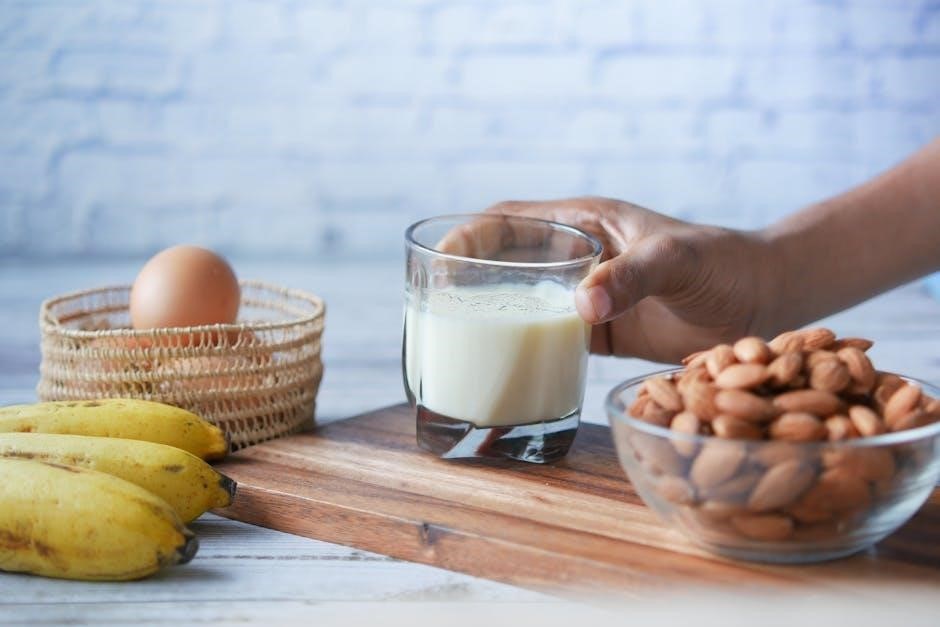
Final Thoughts on Gluten and Dairy-Free Diets
Adopting a gluten and dairy-free diet can be transformative for those with sensitivities or intolerances․ It requires careful planning but offers numerous health benefits, such as improved digestion and reduced inflammation․ With the right resources, like a gluten and dairy-free food list PDF, individuals can navigate their dietary needs with confidence․ This guide serves as a valuable starting point, providing clarity and structure․ Remember, this lifestyle is not just about restrictions—it’s about embracing a wide variety of nutritious, flavorful foods․ By staying informed and prepared, anyone can thrive on a gluten and dairy-free diet․ The key is to focus on what you can eat, not what you’re avoiding, and to explore the vibrant world of gluten and dairy-free options available today․
Next Steps for a Successful Diet
Once you’ve embraced a gluten and dairy-free lifestyle, the next steps involve consistent implementation and exploration․ Start by incorporating the foods listed in your gluten and dairy-free food list PDF into daily meals, ensuring variety and nutrition․ Plan weekly meals, stock your pantry with essentials, and explore new recipes․ Gradually experiment with new ingredients and flavors to keep your diet exciting․ Reorganize your grocery shopping routine to prioritize gluten and dairy-free options․ Additionally, set realistic goals, track your progress, and seek support from online communities or friends with similar dietary preferences․ Celebrate small victories and stay motivated by focusing on how these changes benefit your health and well-being․ Consistency and patience are key to making this diet a long-term success․
